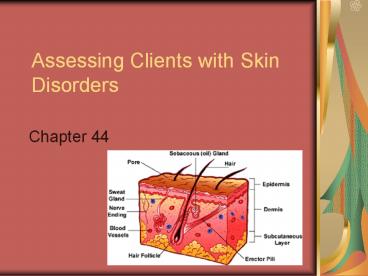Assessing Clients with Skin Disorders PowerPoint PPT Presentation
Title: Assessing Clients with Skin Disorders
1
Assessing Clients with Skin Disorders
- Chapter 44
2
Integumentary System
- Functions
- 1. Protects body from injury
- 2. Provides a barrier to loss of fluids
- 3. Sensory - touch, pressure,pain, and
temperature - 4. Regulates body temperature via sweat glands
- 5. Production of vitamin D
3
Skin
- 2 Layers
- Epidermis
- outer layer, protection, stores melanin
- epithelial cells
- Dermis
- inner layer, temperature regulation
- connective tissue, contains hair follicle, sweat
glands and sebaceous glands
4
Layers of the Skin
5
Skin Color
- 1. Erythema
- reddening of the skin
- fever, inflammation, sunburn, drug reaction
- 2. Cyanosis
- bluish discoloration
- poor oxygenation of hemoglobin
6
Skin Color
- 3. Pallor
- paleness of skin
- shock, fear, anemia or hypoxia
- 4. Jaundice
- yellow-to-orange skin color
- hepatic disorders
7
- 3 Types
- Sebaceous - Oil
- to soften and lubricate the skin
- Sudoriferous - Sweat
- to regulate body temperature by excretion of
sweat - Ceruminous - located in external ear canal
- secrete cerumen, sticky trap for foreign materials
8
The Hair and Nails
- Protective Function
- Hair
- cushions the scalp
- eyelashes and eyebrows protect the eyes
- provides insulation in cold weather
- Nails
- protects fingers, toes, aid grasping
9
The Health Assessment Interview
- Determine problems with the integumentary system
- Describe any skin problems or injuries, nail
problems or scalp problems you have had. - Is your skin and/or scalp dry or oily?
- Do you have any skin pain, burning or itching?
10
The Physical Assessment
- Can be part of head-to-toe or focused assessment
- Assessment through inspection and palpation
- Assess for
- color, lesions, temperature,texture, moisture,
turgor and edema
11
Assessments?
12
The Physical Assessment
- Inspect color
- pallor
- cyanosis
- jaundice
- Inspect for lesions
- irregular skin, rash, hives, psoriasis - scaly
red patches
13
The Physical Assessment
- Palpate the skin for temperature
- warm with fever
- cool in shock or decreased blood flow
- Palpate skin for texture
- smooth or coarse
- Palpate skin for moisture
- dry, moist, diaphoretic - M.I., shock
14
The Physical Assessment
- Palpate for Turgor
- pinching skin over collar bone or back of hand
- decreased in dehydration tenting
- increased in edema
- Assess for edema
- accumulation of fluid in body tissues
- depress skin over ankle
15
The Physical Assessment
- Rate the Edema
- 1 slight pitting
- 2 deeper pit
- 3 obvious pit, extremities are swollen
- 4 the pit remains
- Edema occurs in cardiovascular disease, renal
failure and cirrhosis of liver
16
(No Transcript)
17
Lymph Edema
18
The Physical Assessment
- Hair
- inspect distribution and quality
- palpate for texture
- inspect the scalp for lesions
- Nails
- inspect for curvature, color and thickness
19
(No Transcript)
20
Variations in the Older Adult
- Loss of subcutaneous tissue
- wrinkles, sagging, decreased turgor
- Skin tags
- small flaps of excess skin
- Decreased hair and nail growth
- Liver spots
- small flat brown macules
21
Primary Skin Lesions
- Macule
- flat color change in the skin - freckle
- Papule
- elevated palpable mass with circumscribed boarder
- elevated mole - Nodule
- elevated, solid mass extending deeper - lipoma
22
Primary Skin Lesions
- Vesicle
- fluid filled with thin translucent walls -
blister - Wheal
- larger than vesicle - insect bite, hives
- Pustule
- pus filled vesicle - acne
- Cyst
- elevated, encapsulated mass - sebaceous cyst
23
Skin Lesions
24
Secondary Skin Lesions
- Atrophy
- translucent, dry, paperlike skin resulting from
thinning or wasting away due to loss of elastin - Ulcer
- deep crater-like, irregular shaped area of skin
loss extending into the dermis - Fissure
- cracks with sharp edges - corner of mouth, feet
25
Vascular Skin Lesions
- Port-wine stain
- lg. Flat mass of blood vessels on skin surface
- Strawberry mark
- bright red, raised cluster of immature
capillaries - Petechiae
- flat, red-purple freckles caused by tiny
hemorrhages
26
Vascular Skin Lesions
- Ecchymosis
- bruising - release of blood into surrounding
tissues - trauma, hemophilia, liver disease
- Hematoma
- similar to ecchymosis but is raised, swollen
27
Documenting general appearance
28
What terms describe this skin?
29
Lymphaedema
30
What would you document?
31
(No Transcript)
32
Skin our protector our whole life!

